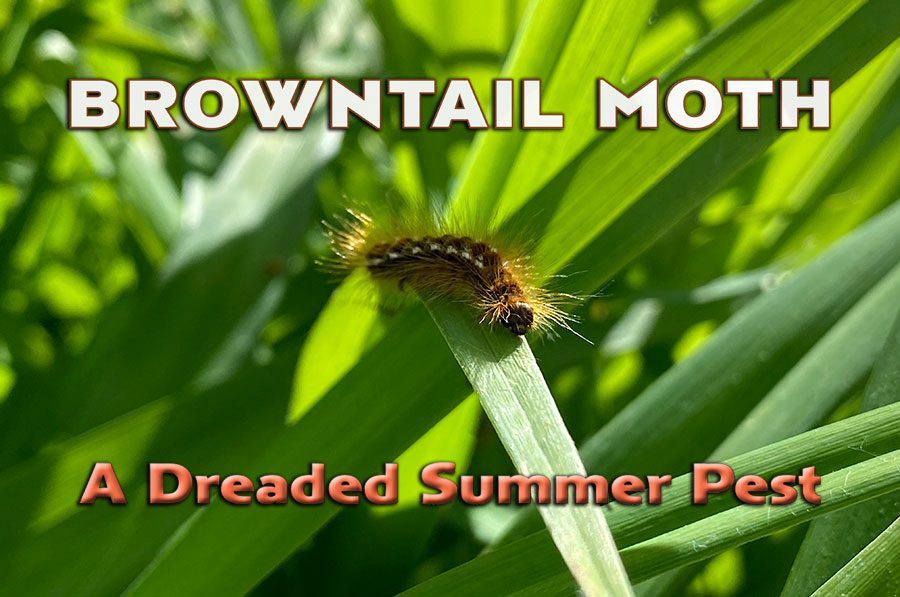by T.S. Chamberland | photography provided by Pine State Pest Solutions
Ah, it’s finally spring!
Before we know it, summer will be upon us. Warm, sunny days lounging on the beach, kayaking, swimming, getting together with friends and families for cookouts, and even exploring the trails awaits us after a long, cold winter.
Sadly, so does browntail moth season.
Nothing spoils the memories of a fantastic day of summertime fun quite like an itchy, irritating rash caused by things unseen. It’s challenging to know what to wear and how to protect yourself if you’re one of the many who suffer from browntail moth reaction. And let’s be frank, it’s almost a misnomer to call it browntail moth rash, since the irritant is actually produced when the insect is in the caterpillar stage.
A little history on this invasive insect
By most accounts, researchers believe that this problematic species of moth was introduced to Massachusetts in the late 1800s, most likely on a shipment from Europe. These pests spread throughout New England and Nova Scotia, destructively consuming foliage and vegetation. The first large outbreak in Maine was in the early 1900s. While their population has fluctuated over the last century, we are currently amid an outbreak “on a scale that has not been experienced in 70 years,” according to a University of Maine, School of Biology and Ecology research paper in 2021.
Once predominantly infesting islands and waterways, browntail moths have migrated further inland – becoming quite a nuisance for trees, plant life, and people. If you’ve taken a drive almost anywhere recently, you may have seen these nests in the trees along the roadside or near bodies of water. According to Parker Adams, owner and president of Pine State Pest Solutions, the chief reason for the shift is the “tunnel effect or draft” that is created by vehicles moving in opposing directions. This provides the insects with air currents they need to move from location to location. It’s also one of the reasons that it’s been such a challenge to eliminate these pests.
“They’ve been around for over a century now,” Adams states. “They come and go.”
There are no clear answers as to why the numbers of browntail caterpillars has risen in the past few years. Studies are being conducted to understand what might be factors in the rise and fall of infestations. Adams says that one area of focus at the moment is trying to understand why the morphing insects have traveled as far inland as they have, as they’ve mainly been an issue around the coast and waterways until recently.
Identifying their fortresses of misery to come
February has been designated Browntail Moth Awareness Month in Maine, in part because this is the best time of year to identify and eliminate nests. Over the past five years, the numbers of these caterpillars have ballooned, causing many people to endure uncomfortable and irritating rashes as the hairs – laden with a toxin the insect produces – become airborne and come into contact with the skin.
“Awareness has definitely risen in the last few years,” explains Adams. “Now with education and awareness increasing, people are looking up to their trees in January, February, and March.”
What specifically should you be looking for up in those trees? Adams describes the telltale sign of a nest as what appears to be “stubborn leaves.” These leaves are actually part of the browntail caterpillars’ nest, helping it survive the cold of winter. The dead leaves are wrapped in a white, silky web.
“The best day to identify them on your own is a sunny day,” Adams details. “Looking up with the sun at your back, you can kind of see a shine or shimmer, and that is the silk reflecting the sun.”
If you see that reflection, then it’s most likely a browntail caterpillar colony waiting to emerge and wreak havoc on your outdoor fun, not just stubborn leaves that clung to their sprouting spot, defying the seasonal foliage rules.
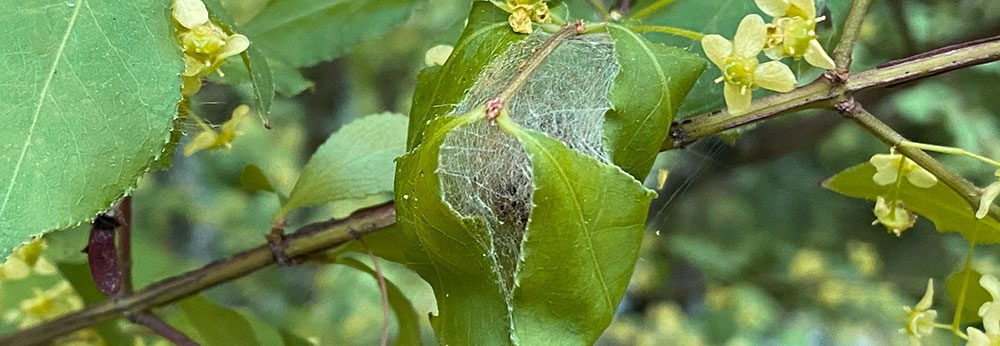

Generally speaking, Adams describes these nests as being present at the “crown or the top” of the tree, though they can be found on the lower branches, often indicating a bigger infestation.
So, what exactly causes the rash?
The browntail moth has four life stages: egg, larvae, pupal, and adult. The stage that causes humans grief in the form of that miserable rash and more serious respiratory issues is pupal. During this phase of the caterpillar’s life, hairs break off or are shed that contain that toxic substance mentioned before. It’s that toxin with which many people’s skin and respiratory systems react, according to the Maine Department of Agriculture Conservation and Forestry.
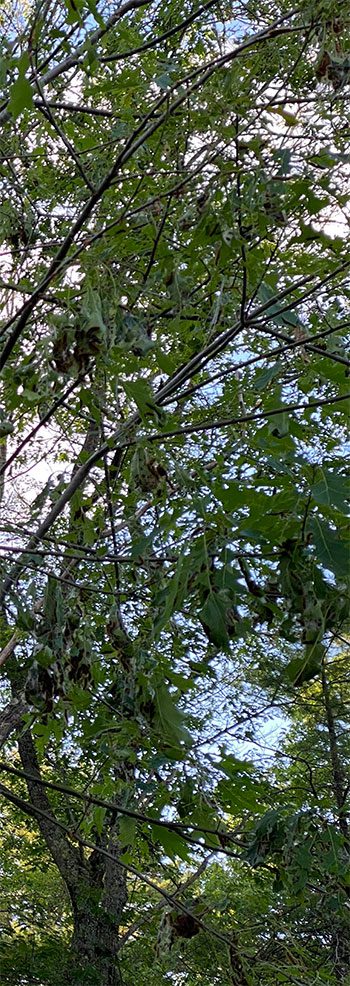

There’s no foolproof way to safeguard against coming into contact with the toxic hairs, especially when anything from wind, or yard work like raking and lawnmowing, can churn up any hairs in the vicinity. So, if you happen to be one of the unfortunate ones who has a reaction to the hairs, taking precautions like covering your skin to do yard work, wearing light coverups, and avoiding swimming or outdoor activities in known heavily infested areas might be the only thing that stands between you and any serious discomfort. Maine.gov recommends jumping in a cool shower and changing into clean clothes after outdoor activities that may have exposed you to the hairs. Also, avoid line drying your clothes outdoors because the hairs could get on the garments. Some other things worth noting are that these hairs remain toxic for up to three years. While the most prevalent exposure period is May to July, reactions are still possible outside of that timeframe, and any reaction can last from a few hours to several days. If you have a severe reaction, it’s best to contact your physician.
Treating the trees
So, you discovered you have infected trees. Now what?
There are a few common methods to reduce and remove these nests. If you want to attempt it on your own, following a highly recommended protocol (you can find information on Maine.gov and PineStatePest.com) is advised. Tree clipping tends to be the method for do-it-yourselfers, though it’s also employed by arborists and the like.
“One option that has been used for centuries is clipping the trees,” explains Adams. “Where that is most useful is with apple trees, fruit trees, and cherry trees.”
Those types of trees are naturally shorter and lend themselves to this approach, as it’s easy to reach the crowns. Clipping is also the most environmentally friendly way to eradicate the nests. Once removed (take care to do this with caution), the nests should be carefully and safely burned or alternatively soaked in soapy water then discarded.
Another method is injecting the trees with a systemic chemical that travels through the tree to its leaves, killing the caterpillars once they’ve fed on the foliage. Timing is crucial with this method to ensure the leaves the insects eat are carrying the pest control. This means it should be done when the leaves are budding, which coincides with the caterpillar’s post-winter emergence from their nests.
The last “real” option, according to Adams is a chemical application with either all-natural or more environmentally friendly agents “outside of synthetic chemicals” that are sprayed on the foliage of the trees. This also taints the leaves so the caterpillars die after consuming them.
Pest control companies like Pine State Pest Solutions work with arborists, most commonly to determine where to use the trunk injection option most efficiently. Pine State Pest offers the injection treatment – often utilized when spraying is not possible – as well as spraying, and they have the right equipment that enables them to reach the crowns of trees and difficult to get at areas. Adams says that his company’s approach to minimize impact to other foliage and the environment is to apply the regimen early and to use environmentally friendly methods.
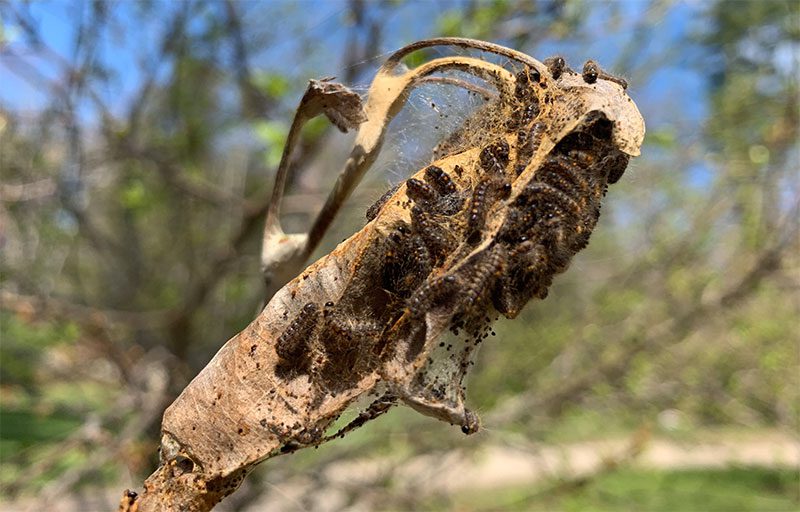

The most effective time to treat the trees is early in the season when the caterpillars are small, eliminating them when they are more susceptible to the treatments.
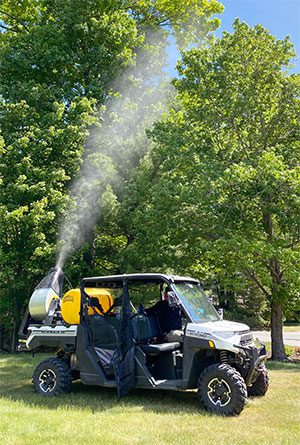

Preventative measures
The only way to truly reduce potential reinfestation is to be vigilant and treat the trees with trunk injection yearly. Other ways to minimize browntail moth nests would be to turn off outside lights that attract the moths. Light traps might seem like a good idea, says Adams, but they may end up attracting more moths than they eliminate, providing more opportunity for these pests to mate and lay their eggs in nests for the next year.
“When they go to moth, we recommend people keep lights off at night outside,” Adams explains.
Light primarily attracts male moths, as they are searching for females to mate with. So, in the summer months when the caterpillars have moved to the moth stage, minimizing outside light at night is one helpful way to deter the population. That combined with the yearly tree treatment will hopefully help decrease the number of caterpillars looking to nest. But is yearly treatment necessary?
“Unfortunately, if you’re treating your property and your neighbor isn’t and there’s significant infestation in the area, they can potentially blow back into the trees, lay eggs, and establish themselves again,” elaborates Adams. “That’s kind of the uphill battle we’ve been seeing.”
Pine State Pest Solutions
Auburn | 207.795.1100 | pinestatepest.com
T.S. is a native of Lewiston who first aspired to become a writer during her sophomore year at Lewiston High School. She has written for a variety of local Maine newspapers and publications since 2006.
-
Community and growth are of particular interest to this New England Patriots fan and she enjoys fitness, beachcombing, whiskey and wine tastings, as well as travel and time with family and friends.


